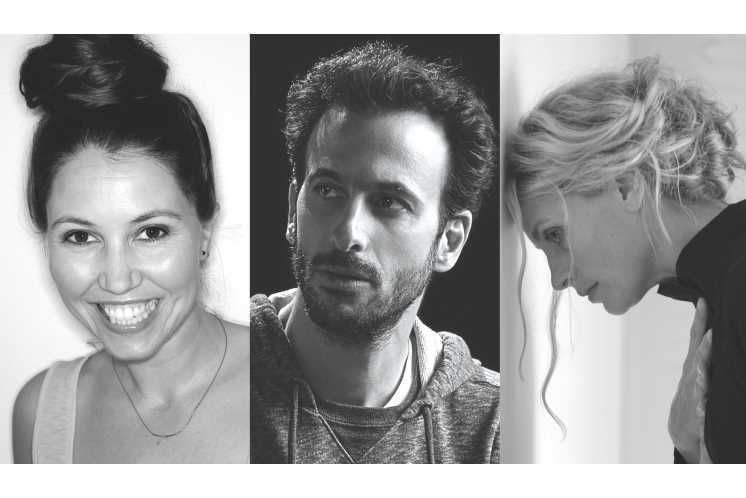Ten years ago, AD Alistair Spalding appointed his first Associate Artist, turning Sadler’s Wells from a receiving house into one which also instigates creative work in house. The list of Associates has grown to sixteen Artists, three Resident Companies and one Associate Company—into a powerhouse of dance under one umbrella.
Tonight’s triple bill gives us a taste of work-in-progress from three Associates: ZooNation’s Kate Prince, Kidd Pivot’s Crystal Pite, and Hofesh Shechter, each with a distinctive voice and signature style.
But who should open, who should close, who be the one in the middle? Juxtaposition can undermine and redefine. Did each artist know what the others were offering? Was there any attention to the arc of the programme?
Seems to me we are privileged to watch the creative spark in action with the usual rehearsal moments of hesitation, tedium, honing, thinking aloud—a prelude to what will be, maybe.
Director Prince’s Smile is a part of a trilogy planned by its choreographer and performer Tommy Franzén; so is Shechter’s the barbarians fall in love. And Pite’s A Picture of You Falling is a new version of a duet from The Second Person created for NDT in 2007—it does have a feel of déjà vu about it.
Two of the pieces have text, and Smile is famously the song Charlie Chaplin wrote, its words carrying the essence of the dance. Words, words, words. Contemporary dance is a broad church.
Pite’s A Picture of You Falling is the standout piece for me: in the middle somewhat elevated (apologies to William Forsythe for whom Pite danced). Text her own, music by Owen Belton, voice Kate Strong, a couple dance out a relationship, encircled by tall lights casting film noir shadows and doubts.
A narrative illustrated by the body, the repository of our tales whatever the culture and age, Beckettian in its frugal lines, Joycean too. ‘This is your voice’, ‘here you are again’, ‘welcome back’, ‘this a picture of you as a young woman’, ‘this is your hand’, head, neck, mouth… The same for the man as for the woman.
Bodies arch and twine, memory banks, measuring space and their place in it. Camera shutter lighting (Robert Sondergaard) picking them out of the darkness, remembered snapshots, ‘the light is changing’—the drama of light and living.
‘This is the sound of your heart hitting the floor’: bodies articulating, flexing every joint and muscle, hard and soft, writing with their souls. ‘This is the place’. A room is described, remembered, where it took place.
The narrative is spare, minimal, the bodies (Anne Plamandon and Peter Chu) intense, as the spotlight watchers move around them—who are they? ‘This is how it ends’. An Alain Resnais movie?
Its sophistication and intelligence is stimulating after the obviousness of Smile’s Charlie Chaplin homage, the mask of a clown, a narrative that uses his tropes.
‘Smile though your heart is breaking’—you know the rest. Tommy Franzén is a lovely endearing performer with great plasticity of movement, and is a perfect fit for Chaplin, but this slapstick shtick narrative dance is a little saccharine at the moment.
In his dressing room backstage he dances in front of three mirrors à la Gene Kelly and Fred Astaire, flops into a laundry basket, tangles with a dust sheet, dances with a coat stand and ladies hat and coat, muses, does that dance with bread rolls on a fork, which morph into Adidas trainers on the screen (Andrzej Goulding projection designer).
A pleasant family show for a young audience, it wrings nostalgia from its period musical medley. But one must reserve a little judgement for the finished product that is promised.
Likewise with Shechter’s the barbarians in love, subtitled (ironically?) The truth lies here. Shechterian self-analysis: a fusion of eighteenth century Couperin (Jordi Savall & Le Concert Des Nations) and twenty-first century electronica superimposed by Natascha McElhone’s voice quizzing the man himself. Hmm.
In a murky landscape (of the troubled soul?) six dancers group in loose bunches, circles and line-up for analysis. The voice (a higher being?)—‘I am perfect’, 'you are one’—reads them numbered lessons. A manual for existence? The dancers stand and listen.
Signature crouching moves adapted to the ‘strict structure’ of Baroque music, which in essence means right arms raised in classical pose as well as shaking them at heaven, first and second port de bras, follow.
What do you think you’re doing, Hofesh, the voice asks. Trying to make a dance piece. What are you saying? I don’t know, he says. It’s about me. About innocence. About a three / four-year-old me. Is there a shrink in the house? I may be paraphrasing, their voices are drowned by a tinnitus background hum.
‘I’m a fucking walking cliché’. He is laughing at himself, but is it a smoke screen? Dancers barely visible at times, the shadows hollowing their bodies into corpses, into transient beings. ‘You are not alone’.
But as he says about his previous work, SUN, it’s only a dance work; don’t read too much into it… So why is he baring his soul in a mock confessional tone with its ums and you knows? Baring the dancer’s bodies to our gaze?
He’s not sure what he’s doing. ‘Everything comes to an end’. A dystopian vision, confused psyche, beautiful and ugly, elegant and shambling dance, Shechter sure puts his fans to the test. Much work remains to be done.
